MAN304: Strategy Formulation for International Business in Pakistan
VerifiedAdded on 2022/08/26
|7
|1922
|9
Report
AI Summary
This report analyzes the international business environment in Pakistan, focusing on Starbucks as a case study. It begins with an overview of recent news regarding Pakistan's trade and investment landscape, including its current account deficit and the impact of the China-Pakistan Economic Corridor (CPEC). The report then delves into the PESTEL factors (Political, Economic, Social, Technological, Environmental, and Legal) affecting business operations in Pakistan, providing detailed insights into each area. It also identifies potential risks that Starbucks might face, such as political instability, economic volatility, and cultural considerations. Finally, the report recommends a direct investment strategy as the most suitable entry point for Starbucks, highlighting the benefits of this approach while acknowledging the associated challenges and offering strategic recommendations for success in the Pakistani market. The report utilizes various sources and provides a comprehensive analysis of the business environment.
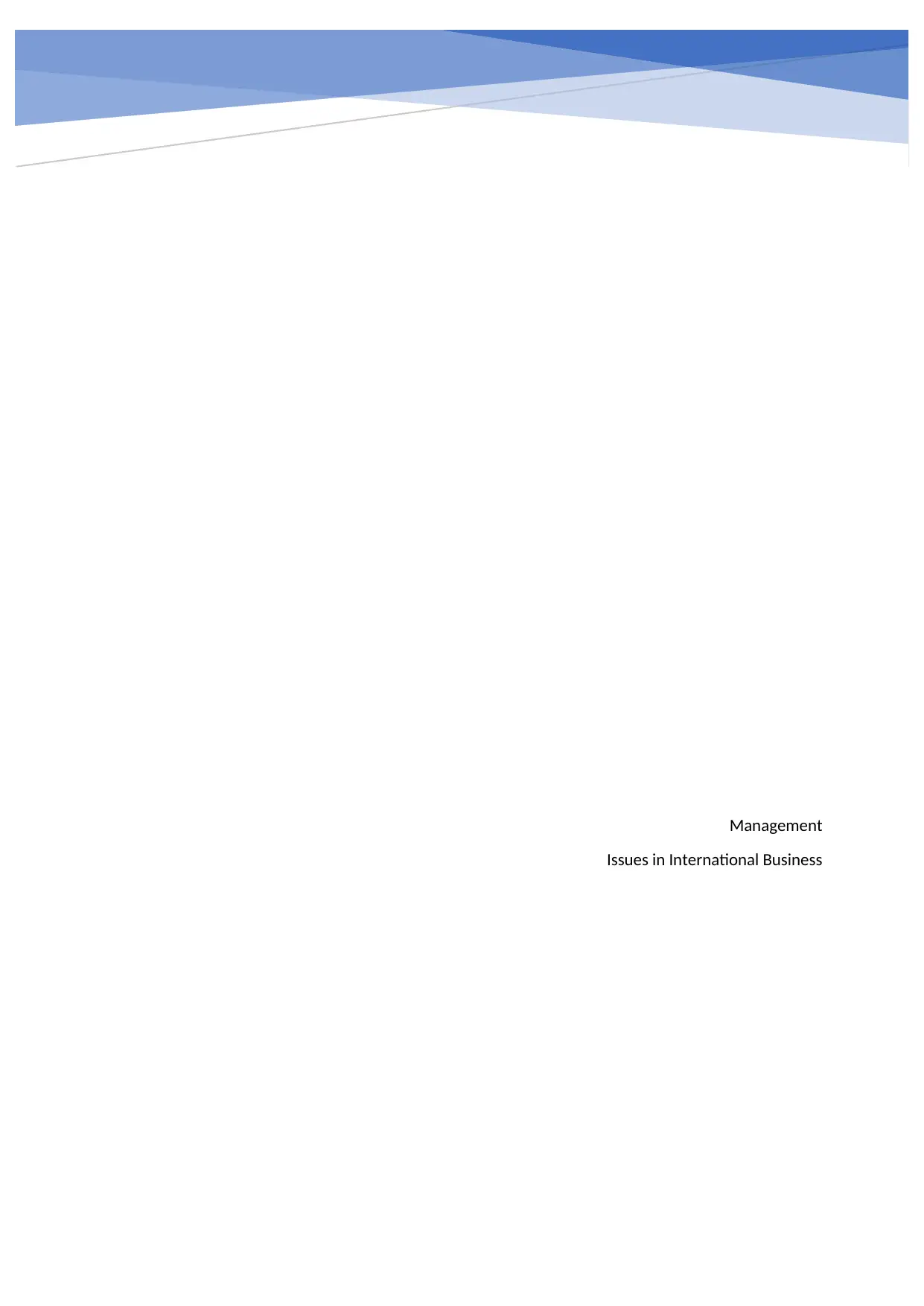
Management
Issues in International Business
Issues in International Business
Paraphrase This Document
Need a fresh take? Get an instant paraphrase of this document with our AI Paraphraser
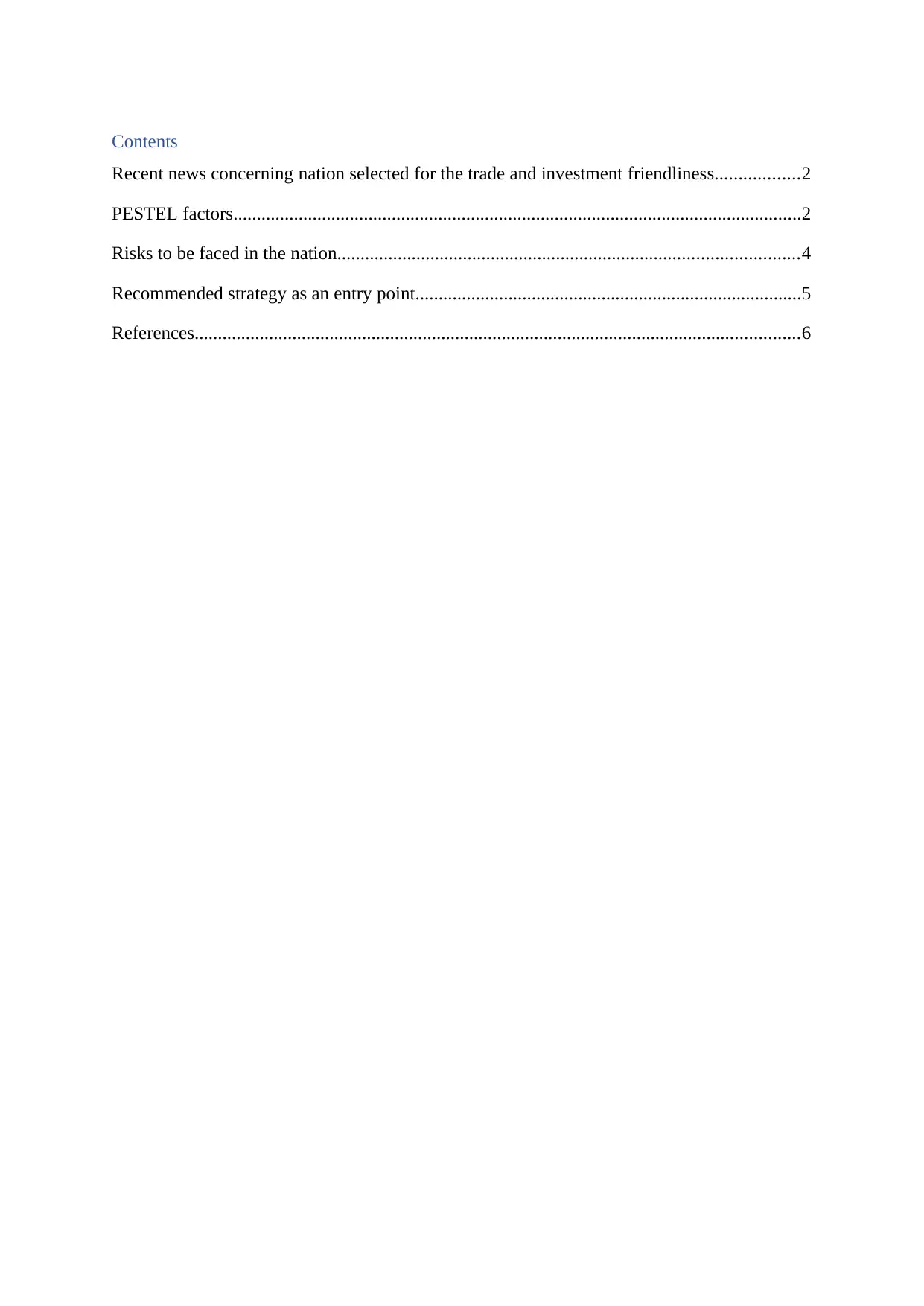
Contents
Recent news concerning nation selected for the trade and investment friendliness..................2
PESTEL factors..........................................................................................................................2
Risks to be faced in the nation...................................................................................................4
Recommended strategy as an entry point...................................................................................5
References..................................................................................................................................6
Recent news concerning nation selected for the trade and investment friendliness..................2
PESTEL factors..........................................................................................................................2
Risks to be faced in the nation...................................................................................................4
Recommended strategy as an entry point...................................................................................5
References..................................................................................................................................6
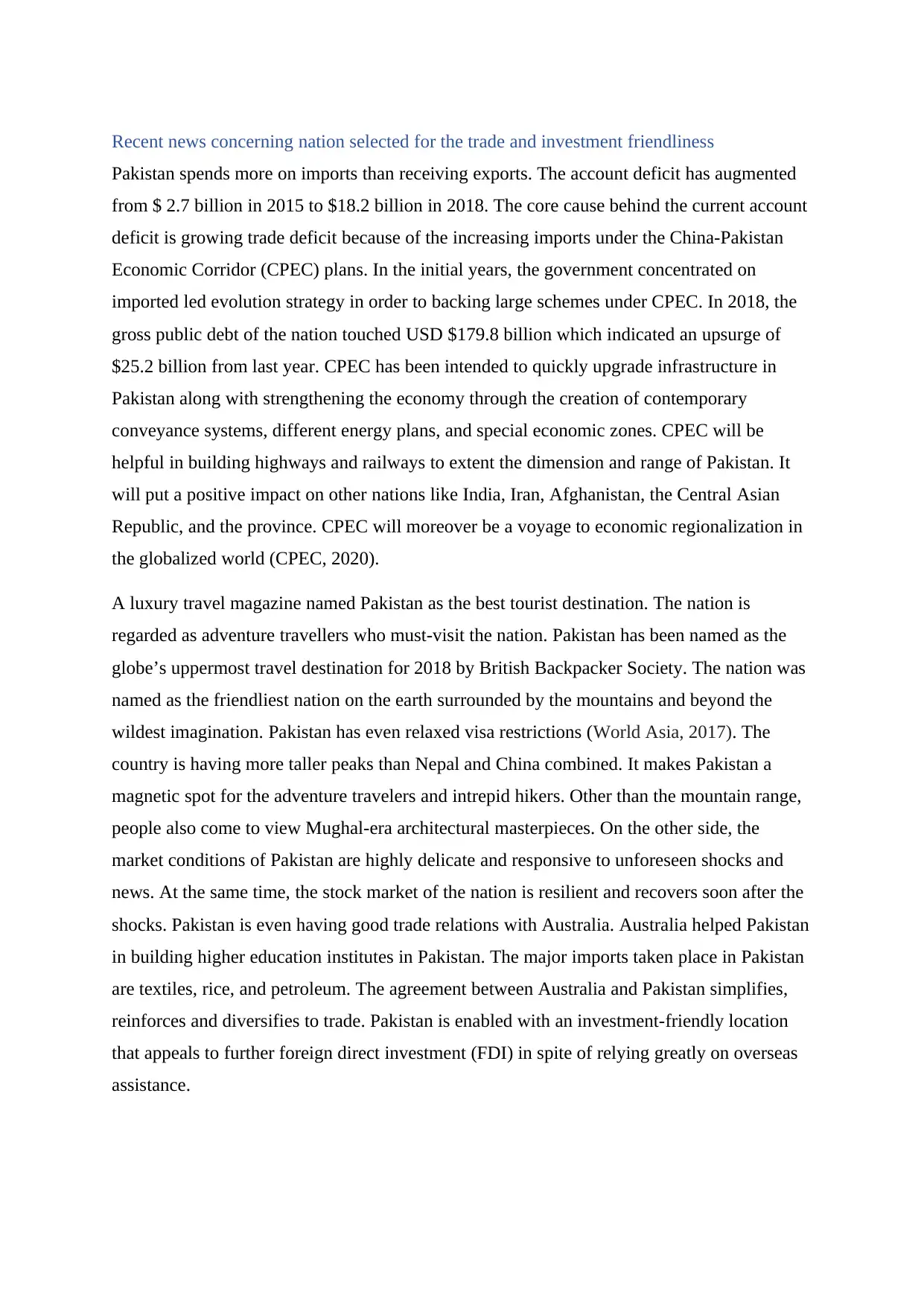
Recent news concerning nation selected for the trade and investment friendliness
Pakistan spends more on imports than receiving exports. The account deficit has augmented
from $ 2.7 billion in 2015 to $18.2 billion in 2018. The core cause behind the current account
deficit is growing trade deficit because of the increasing imports under the China-Pakistan
Economic Corridor (CPEC) plans. In the initial years, the government concentrated on
imported led evolution strategy in order to backing large schemes under CPEC. In 2018, the
gross public debt of the nation touched USD $179.8 billion which indicated an upsurge of
$25.2 billion from last year. CPEC has been intended to quickly upgrade infrastructure in
Pakistan along with strengthening the economy through the creation of contemporary
conveyance systems, different energy plans, and special economic zones. CPEC will be
helpful in building highways and railways to extent the dimension and range of Pakistan. It
will put a positive impact on other nations like India, Iran, Afghanistan, the Central Asian
Republic, and the province. CPEC will moreover be a voyage to economic regionalization in
the globalized world (CPEC, 2020).
A luxury travel magazine named Pakistan as the best tourist destination. The nation is
regarded as adventure travellers who must-visit the nation. Pakistan has been named as the
globe’s uppermost travel destination for 2018 by British Backpacker Society. The nation was
named as the friendliest nation on the earth surrounded by the mountains and beyond the
wildest imagination. Pakistan has even relaxed visa restrictions (World Asia, 2017). The
country is having more taller peaks than Nepal and China combined. It makes Pakistan a
magnetic spot for the adventure travelers and intrepid hikers. Other than the mountain range,
people also come to view Mughal-era architectural masterpieces. On the other side, the
market conditions of Pakistan are highly delicate and responsive to unforeseen shocks and
news. At the same time, the stock market of the nation is resilient and recovers soon after the
shocks. Pakistan is even having good trade relations with Australia. Australia helped Pakistan
in building higher education institutes in Pakistan. The major imports taken place in Pakistan
are textiles, rice, and petroleum. The agreement between Australia and Pakistan simplifies,
reinforces and diversifies to trade. Pakistan is enabled with an investment-friendly location
that appeals to further foreign direct investment (FDI) in spite of relying greatly on overseas
assistance.
Pakistan spends more on imports than receiving exports. The account deficit has augmented
from $ 2.7 billion in 2015 to $18.2 billion in 2018. The core cause behind the current account
deficit is growing trade deficit because of the increasing imports under the China-Pakistan
Economic Corridor (CPEC) plans. In the initial years, the government concentrated on
imported led evolution strategy in order to backing large schemes under CPEC. In 2018, the
gross public debt of the nation touched USD $179.8 billion which indicated an upsurge of
$25.2 billion from last year. CPEC has been intended to quickly upgrade infrastructure in
Pakistan along with strengthening the economy through the creation of contemporary
conveyance systems, different energy plans, and special economic zones. CPEC will be
helpful in building highways and railways to extent the dimension and range of Pakistan. It
will put a positive impact on other nations like India, Iran, Afghanistan, the Central Asian
Republic, and the province. CPEC will moreover be a voyage to economic regionalization in
the globalized world (CPEC, 2020).
A luxury travel magazine named Pakistan as the best tourist destination. The nation is
regarded as adventure travellers who must-visit the nation. Pakistan has been named as the
globe’s uppermost travel destination for 2018 by British Backpacker Society. The nation was
named as the friendliest nation on the earth surrounded by the mountains and beyond the
wildest imagination. Pakistan has even relaxed visa restrictions (World Asia, 2017). The
country is having more taller peaks than Nepal and China combined. It makes Pakistan a
magnetic spot for the adventure travelers and intrepid hikers. Other than the mountain range,
people also come to view Mughal-era architectural masterpieces. On the other side, the
market conditions of Pakistan are highly delicate and responsive to unforeseen shocks and
news. At the same time, the stock market of the nation is resilient and recovers soon after the
shocks. Pakistan is even having good trade relations with Australia. Australia helped Pakistan
in building higher education institutes in Pakistan. The major imports taken place in Pakistan
are textiles, rice, and petroleum. The agreement between Australia and Pakistan simplifies,
reinforces and diversifies to trade. Pakistan is enabled with an investment-friendly location
that appeals to further foreign direct investment (FDI) in spite of relying greatly on overseas
assistance.
⊘ This is a preview!⊘
Do you want full access?
Subscribe today to unlock all pages.

Trusted by 1+ million students worldwide
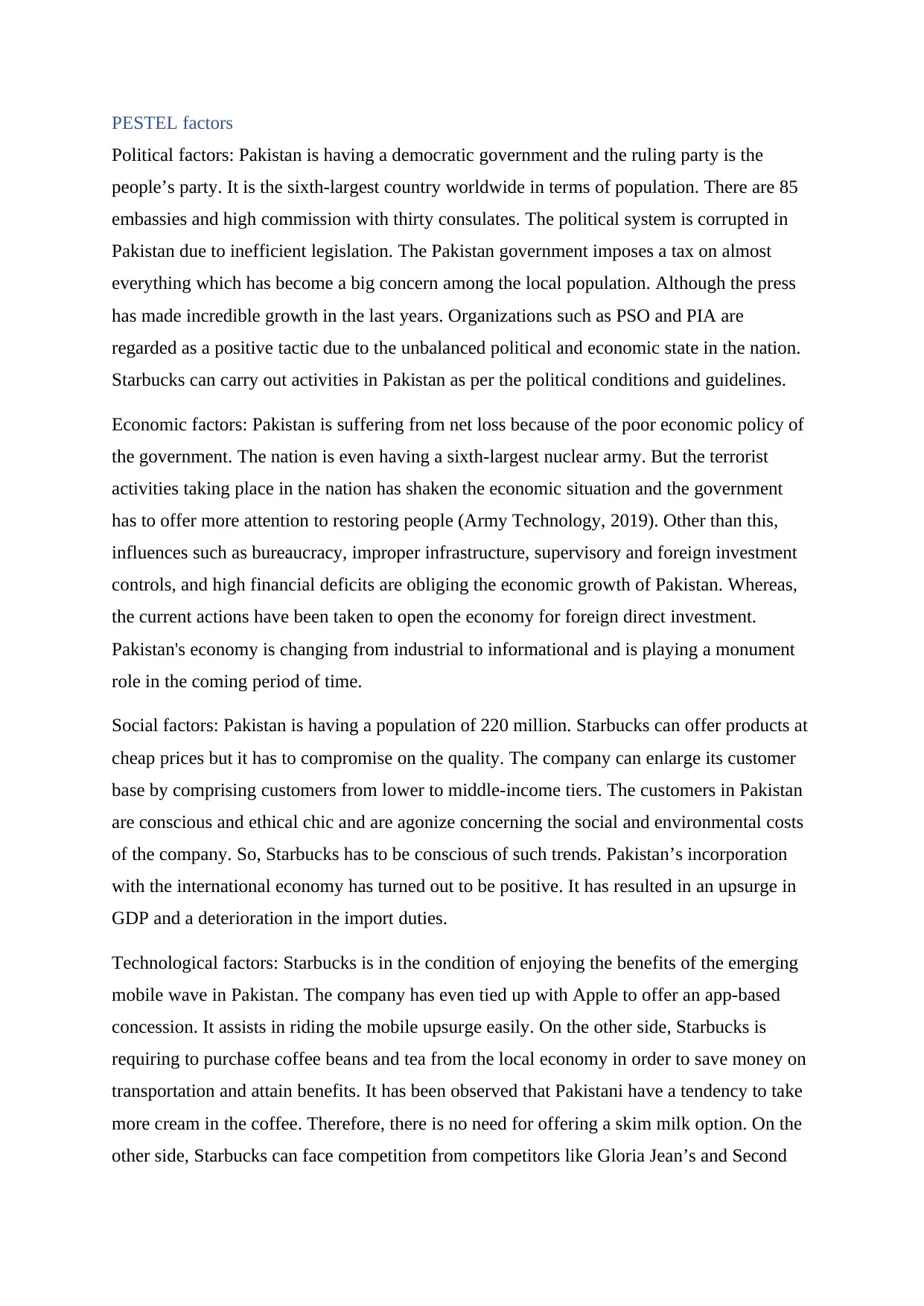
PESTEL factors
Political factors: Pakistan is having a democratic government and the ruling party is the
people’s party. It is the sixth-largest country worldwide in terms of population. There are 85
embassies and high commission with thirty consulates. The political system is corrupted in
Pakistan due to inefficient legislation. The Pakistan government imposes a tax on almost
everything which has become a big concern among the local population. Although the press
has made incredible growth in the last years. Organizations such as PSO and PIA are
regarded as a positive tactic due to the unbalanced political and economic state in the nation.
Starbucks can carry out activities in Pakistan as per the political conditions and guidelines.
Economic factors: Pakistan is suffering from net loss because of the poor economic policy of
the government. The nation is even having a sixth-largest nuclear army. But the terrorist
activities taking place in the nation has shaken the economic situation and the government
has to offer more attention to restoring people (Army Technology, 2019). Other than this,
influences such as bureaucracy, improper infrastructure, supervisory and foreign investment
controls, and high financial deficits are obliging the economic growth of Pakistan. Whereas,
the current actions have been taken to open the economy for foreign direct investment.
Pakistan's economy is changing from industrial to informational and is playing a monument
role in the coming period of time.
Social factors: Pakistan is having a population of 220 million. Starbucks can offer products at
cheap prices but it has to compromise on the quality. The company can enlarge its customer
base by comprising customers from lower to middle-income tiers. The customers in Pakistan
are conscious and ethical chic and are agonize concerning the social and environmental costs
of the company. So, Starbucks has to be conscious of such trends. Pakistan’s incorporation
with the international economy has turned out to be positive. It has resulted in an upsurge in
GDP and a deterioration in the import duties.
Technological factors: Starbucks is in the condition of enjoying the benefits of the emerging
mobile wave in Pakistan. The company has even tied up with Apple to offer an app-based
concession. It assists in riding the mobile upsurge easily. On the other side, Starbucks is
requiring to purchase coffee beans and tea from the local economy in order to save money on
transportation and attain benefits. It has been observed that Pakistani have a tendency to take
more cream in the coffee. Therefore, there is no need for offering a skim milk option. On the
other side, Starbucks can face competition from competitors like Gloria Jean’s and Second
Political factors: Pakistan is having a democratic government and the ruling party is the
people’s party. It is the sixth-largest country worldwide in terms of population. There are 85
embassies and high commission with thirty consulates. The political system is corrupted in
Pakistan due to inefficient legislation. The Pakistan government imposes a tax on almost
everything which has become a big concern among the local population. Although the press
has made incredible growth in the last years. Organizations such as PSO and PIA are
regarded as a positive tactic due to the unbalanced political and economic state in the nation.
Starbucks can carry out activities in Pakistan as per the political conditions and guidelines.
Economic factors: Pakistan is suffering from net loss because of the poor economic policy of
the government. The nation is even having a sixth-largest nuclear army. But the terrorist
activities taking place in the nation has shaken the economic situation and the government
has to offer more attention to restoring people (Army Technology, 2019). Other than this,
influences such as bureaucracy, improper infrastructure, supervisory and foreign investment
controls, and high financial deficits are obliging the economic growth of Pakistan. Whereas,
the current actions have been taken to open the economy for foreign direct investment.
Pakistan's economy is changing from industrial to informational and is playing a monument
role in the coming period of time.
Social factors: Pakistan is having a population of 220 million. Starbucks can offer products at
cheap prices but it has to compromise on the quality. The company can enlarge its customer
base by comprising customers from lower to middle-income tiers. The customers in Pakistan
are conscious and ethical chic and are agonize concerning the social and environmental costs
of the company. So, Starbucks has to be conscious of such trends. Pakistan’s incorporation
with the international economy has turned out to be positive. It has resulted in an upsurge in
GDP and a deterioration in the import duties.
Technological factors: Starbucks is in the condition of enjoying the benefits of the emerging
mobile wave in Pakistan. The company has even tied up with Apple to offer an app-based
concession. It assists in riding the mobile upsurge easily. On the other side, Starbucks is
requiring to purchase coffee beans and tea from the local economy in order to save money on
transportation and attain benefits. It has been observed that Pakistani have a tendency to take
more cream in the coffee. Therefore, there is no need for offering a skim milk option. On the
other side, Starbucks can face competition from competitors like Gloria Jean’s and Second
Paraphrase This Document
Need a fresh take? Get an instant paraphrase of this document with our AI Paraphraser
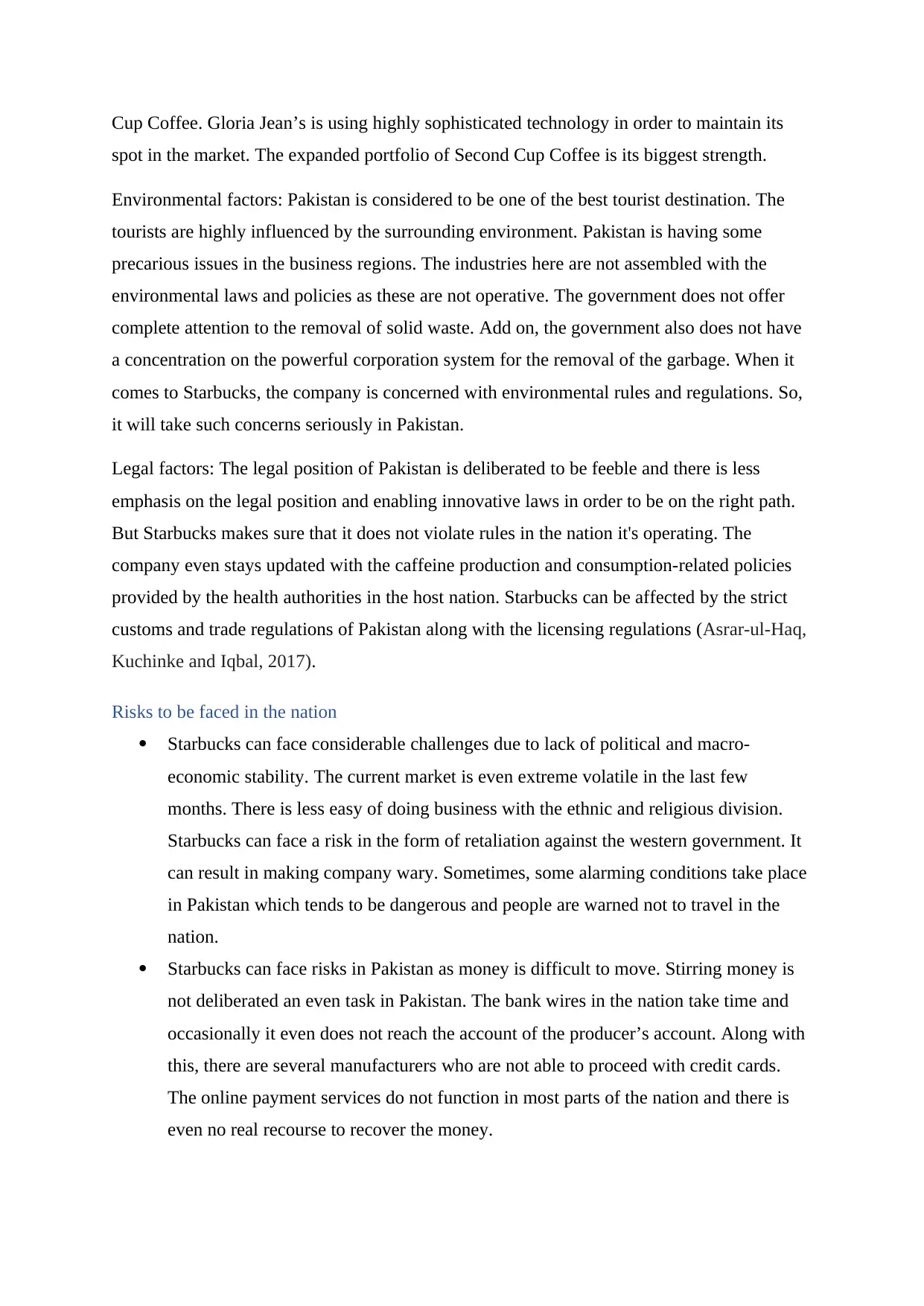
Cup Coffee. Gloria Jean’s is using highly sophisticated technology in order to maintain its
spot in the market. The expanded portfolio of Second Cup Coffee is its biggest strength.
Environmental factors: Pakistan is considered to be one of the best tourist destination. The
tourists are highly influenced by the surrounding environment. Pakistan is having some
precarious issues in the business regions. The industries here are not assembled with the
environmental laws and policies as these are not operative. The government does not offer
complete attention to the removal of solid waste. Add on, the government also does not have
a concentration on the powerful corporation system for the removal of the garbage. When it
comes to Starbucks, the company is concerned with environmental rules and regulations. So,
it will take such concerns seriously in Pakistan.
Legal factors: The legal position of Pakistan is deliberated to be feeble and there is less
emphasis on the legal position and enabling innovative laws in order to be on the right path.
But Starbucks makes sure that it does not violate rules in the nation it's operating. The
company even stays updated with the caffeine production and consumption-related policies
provided by the health authorities in the host nation. Starbucks can be affected by the strict
customs and trade regulations of Pakistan along with the licensing regulations (Asrar-ul-Haq,
Kuchinke and Iqbal, 2017).
Risks to be faced in the nation
Starbucks can face considerable challenges due to lack of political and macro-
economic stability. The current market is even extreme volatile in the last few
months. There is less easy of doing business with the ethnic and religious division.
Starbucks can face a risk in the form of retaliation against the western government. It
can result in making company wary. Sometimes, some alarming conditions take place
in Pakistan which tends to be dangerous and people are warned not to travel in the
nation.
Starbucks can face risks in Pakistan as money is difficult to move. Stirring money is
not deliberated an even task in Pakistan. The bank wires in the nation take time and
occasionally it even does not reach the account of the producer’s account. Along with
this, there are several manufacturers who are not able to proceed with credit cards.
The online payment services do not function in most parts of the nation and there is
even no real recourse to recover the money.
spot in the market. The expanded portfolio of Second Cup Coffee is its biggest strength.
Environmental factors: Pakistan is considered to be one of the best tourist destination. The
tourists are highly influenced by the surrounding environment. Pakistan is having some
precarious issues in the business regions. The industries here are not assembled with the
environmental laws and policies as these are not operative. The government does not offer
complete attention to the removal of solid waste. Add on, the government also does not have
a concentration on the powerful corporation system for the removal of the garbage. When it
comes to Starbucks, the company is concerned with environmental rules and regulations. So,
it will take such concerns seriously in Pakistan.
Legal factors: The legal position of Pakistan is deliberated to be feeble and there is less
emphasis on the legal position and enabling innovative laws in order to be on the right path.
But Starbucks makes sure that it does not violate rules in the nation it's operating. The
company even stays updated with the caffeine production and consumption-related policies
provided by the health authorities in the host nation. Starbucks can be affected by the strict
customs and trade regulations of Pakistan along with the licensing regulations (Asrar-ul-Haq,
Kuchinke and Iqbal, 2017).
Risks to be faced in the nation
Starbucks can face considerable challenges due to lack of political and macro-
economic stability. The current market is even extreme volatile in the last few
months. There is less easy of doing business with the ethnic and religious division.
Starbucks can face a risk in the form of retaliation against the western government. It
can result in making company wary. Sometimes, some alarming conditions take place
in Pakistan which tends to be dangerous and people are warned not to travel in the
nation.
Starbucks can face risks in Pakistan as money is difficult to move. Stirring money is
not deliberated an even task in Pakistan. The bank wires in the nation take time and
occasionally it even does not reach the account of the producer’s account. Along with
this, there are several manufacturers who are not able to proceed with credit cards.
The online payment services do not function in most parts of the nation and there is
even no real recourse to recover the money.
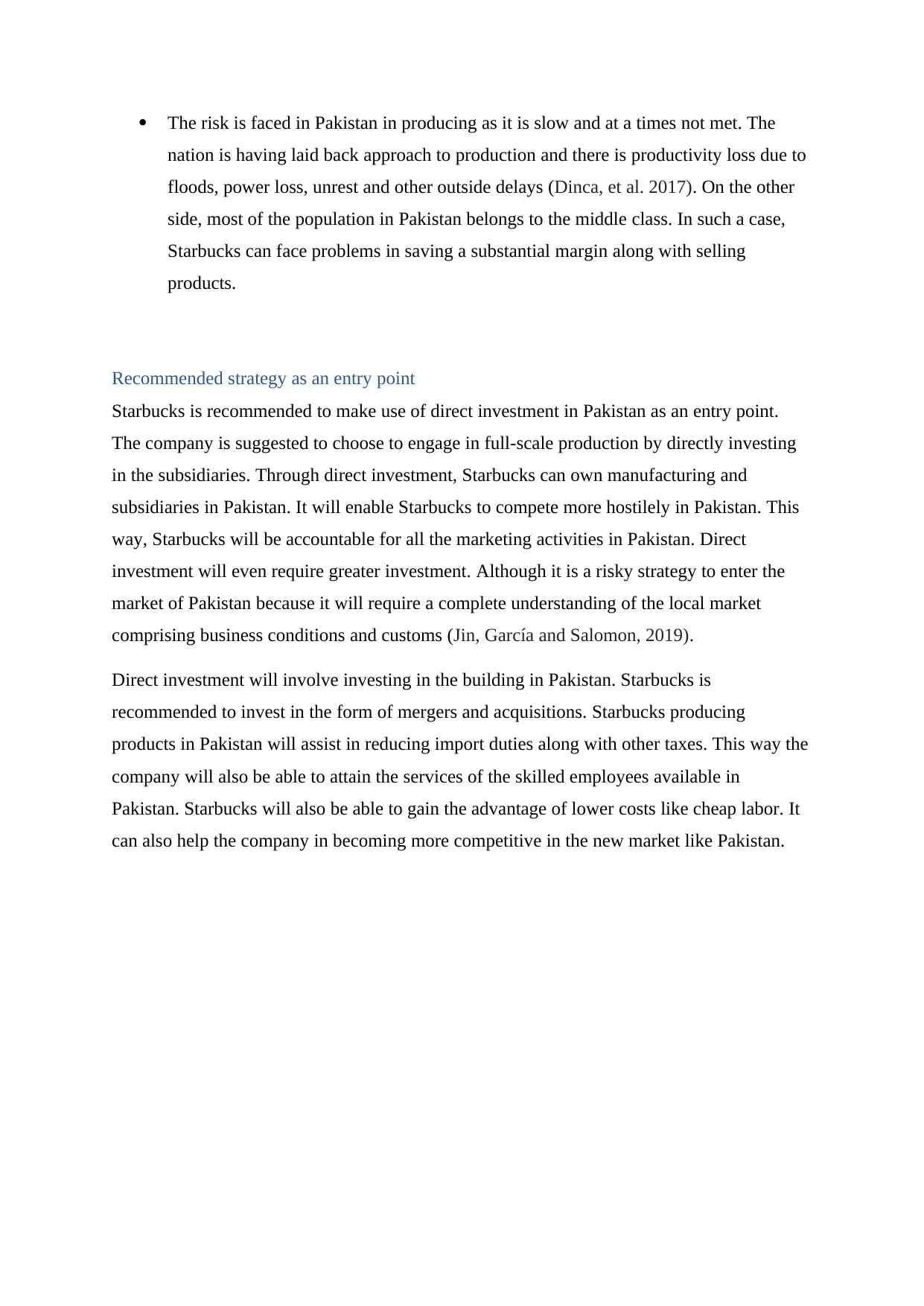
The risk is faced in Pakistan in producing as it is slow and at a times not met. The
nation is having laid back approach to production and there is productivity loss due to
floods, power loss, unrest and other outside delays (Dinca, et al. 2017). On the other
side, most of the population in Pakistan belongs to the middle class. In such a case,
Starbucks can face problems in saving a substantial margin along with selling
products.
Recommended strategy as an entry point
Starbucks is recommended to make use of direct investment in Pakistan as an entry point.
The company is suggested to choose to engage in full-scale production by directly investing
in the subsidiaries. Through direct investment, Starbucks can own manufacturing and
subsidiaries in Pakistan. It will enable Starbucks to compete more hostilely in Pakistan. This
way, Starbucks will be accountable for all the marketing activities in Pakistan. Direct
investment will even require greater investment. Although it is a risky strategy to enter the
market of Pakistan because it will require a complete understanding of the local market
comprising business conditions and customs (Jin, García and Salomon, 2019).
Direct investment will involve investing in the building in Pakistan. Starbucks is
recommended to invest in the form of mergers and acquisitions. Starbucks producing
products in Pakistan will assist in reducing import duties along with other taxes. This way the
company will also be able to attain the services of the skilled employees available in
Pakistan. Starbucks will also be able to gain the advantage of lower costs like cheap labor. It
can also help the company in becoming more competitive in the new market like Pakistan.
nation is having laid back approach to production and there is productivity loss due to
floods, power loss, unrest and other outside delays (Dinca, et al. 2017). On the other
side, most of the population in Pakistan belongs to the middle class. In such a case,
Starbucks can face problems in saving a substantial margin along with selling
products.
Recommended strategy as an entry point
Starbucks is recommended to make use of direct investment in Pakistan as an entry point.
The company is suggested to choose to engage in full-scale production by directly investing
in the subsidiaries. Through direct investment, Starbucks can own manufacturing and
subsidiaries in Pakistan. It will enable Starbucks to compete more hostilely in Pakistan. This
way, Starbucks will be accountable for all the marketing activities in Pakistan. Direct
investment will even require greater investment. Although it is a risky strategy to enter the
market of Pakistan because it will require a complete understanding of the local market
comprising business conditions and customs (Jin, García and Salomon, 2019).
Direct investment will involve investing in the building in Pakistan. Starbucks is
recommended to invest in the form of mergers and acquisitions. Starbucks producing
products in Pakistan will assist in reducing import duties along with other taxes. This way the
company will also be able to attain the services of the skilled employees available in
Pakistan. Starbucks will also be able to gain the advantage of lower costs like cheap labor. It
can also help the company in becoming more competitive in the new market like Pakistan.
⊘ This is a preview!⊘
Do you want full access?
Subscribe today to unlock all pages.

Trusted by 1+ million students worldwide
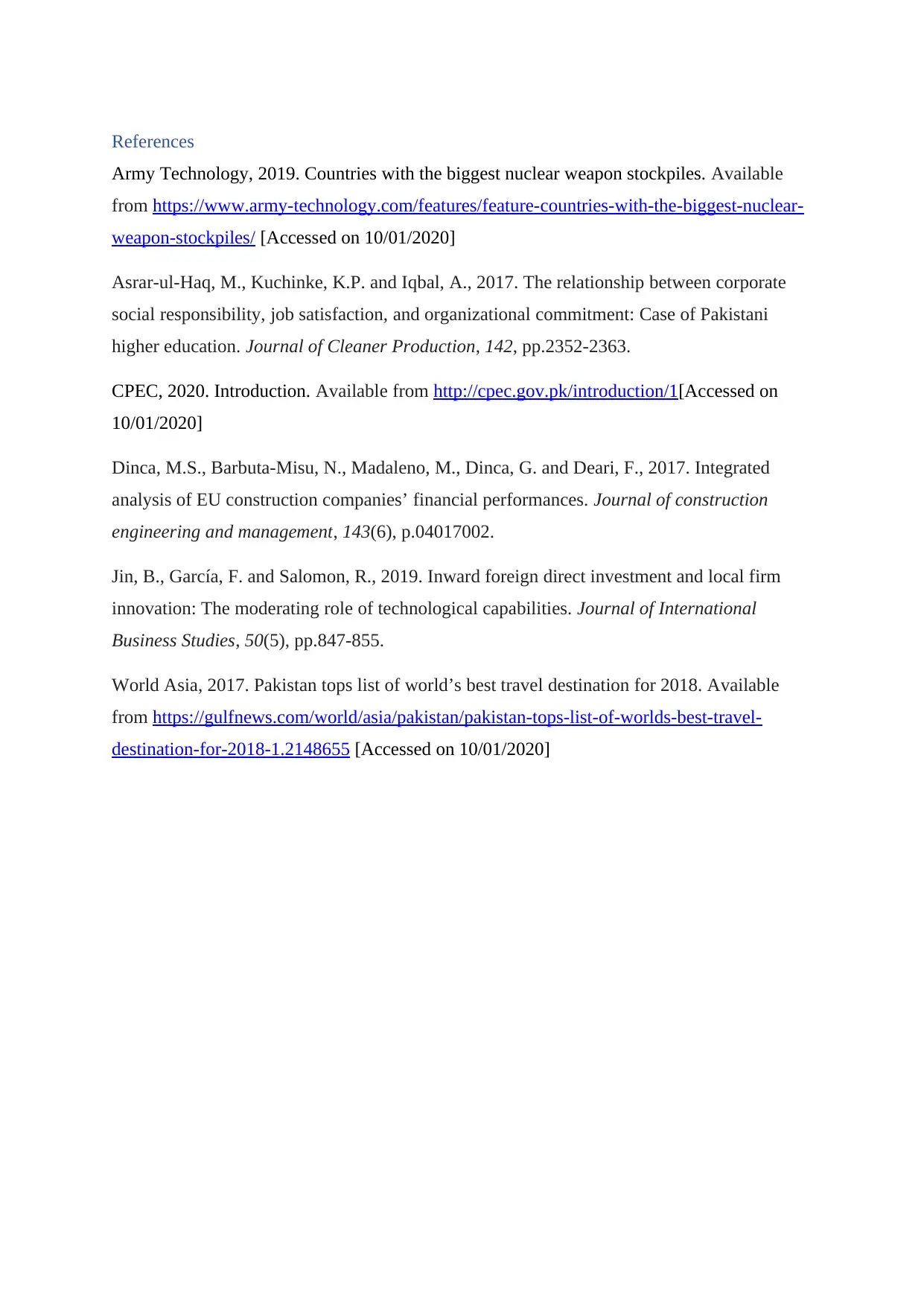
References
Army Technology, 2019. Countries with the biggest nuclear weapon stockpiles. Available
from https://www.army-technology.com/features/feature-countries-with-the-biggest-nuclear-
weapon-stockpiles/ [Accessed on 10/01/2020]
Asrar-ul-Haq, M., Kuchinke, K.P. and Iqbal, A., 2017. The relationship between corporate
social responsibility, job satisfaction, and organizational commitment: Case of Pakistani
higher education. Journal of Cleaner Production, 142, pp.2352-2363.
CPEC, 2020. Introduction. Available from http://cpec.gov.pk/introduction/1[Accessed on
10/01/2020]
Dinca, M.S., Barbuta-Misu, N., Madaleno, M., Dinca, G. and Deari, F., 2017. Integrated
analysis of EU construction companies’ financial performances. Journal of construction
engineering and management, 143(6), p.04017002.
Jin, B., García, F. and Salomon, R., 2019. Inward foreign direct investment and local firm
innovation: The moderating role of technological capabilities. Journal of International
Business Studies, 50(5), pp.847-855.
World Asia, 2017. Pakistan tops list of world’s best travel destination for 2018. Available
from https://gulfnews.com/world/asia/pakistan/pakistan-tops-list-of-worlds-best-travel-
destination-for-2018-1.2148655 [Accessed on 10/01/2020]
Army Technology, 2019. Countries with the biggest nuclear weapon stockpiles. Available
from https://www.army-technology.com/features/feature-countries-with-the-biggest-nuclear-
weapon-stockpiles/ [Accessed on 10/01/2020]
Asrar-ul-Haq, M., Kuchinke, K.P. and Iqbal, A., 2017. The relationship between corporate
social responsibility, job satisfaction, and organizational commitment: Case of Pakistani
higher education. Journal of Cleaner Production, 142, pp.2352-2363.
CPEC, 2020. Introduction. Available from http://cpec.gov.pk/introduction/1[Accessed on
10/01/2020]
Dinca, M.S., Barbuta-Misu, N., Madaleno, M., Dinca, G. and Deari, F., 2017. Integrated
analysis of EU construction companies’ financial performances. Journal of construction
engineering and management, 143(6), p.04017002.
Jin, B., García, F. and Salomon, R., 2019. Inward foreign direct investment and local firm
innovation: The moderating role of technological capabilities. Journal of International
Business Studies, 50(5), pp.847-855.
World Asia, 2017. Pakistan tops list of world’s best travel destination for 2018. Available
from https://gulfnews.com/world/asia/pakistan/pakistan-tops-list-of-worlds-best-travel-
destination-for-2018-1.2148655 [Accessed on 10/01/2020]
1 out of 7